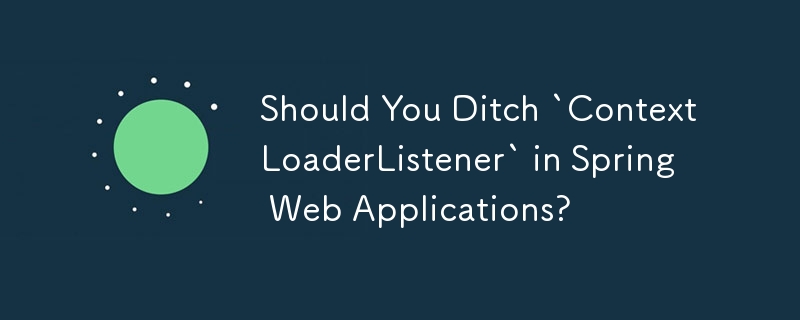Should You Ditch `ContextLoaderListener` in Spring Web Applications?

ContextLoaderListener Revisited
The standard Spring web application uses both a ContextLoaderListener and a DispatcherServlet. While the former is designed to load non-web-related configurations, and the latter solely handles web-related configurations, the question arises: why not use the DispatcherServlet to load all configurations to avoid the complexities of multiple contexts?
Reasons for Multiple Contexts
Historically, the use of both contexts was encouraged to separate web-related concerns from non-web-related ones. This practice offered advantages when sharing services between multiple DispatcherServlets or accessing Spring-wired services from legacy servlets. However, in cases where those conditions do not apply, as suggested in the question, there may be no compelling reason to maintain the webapp-level context.
Justification for Removal
The decision to remove the ContextLoaderListener is ultimately dependent on the specific application requirements. However, if none of the following scenarios apply:
- The need to share services between DispatcherServlets
- Reliance on legacy servlets that require Spring-wired services
- Utilization of filters that integrate with the webapp-level context
Then removing the ContextLoaderListener and relying solely on the DispatcherServlet can simplify the application architecture and potentially address issues related to event handling across contexts.
Caution
When considering the removal of the webapp-level context, carefully assess the impact on background tasks, such as scheduled tasks or JMS connections. If the implementation lacks a
The above is the detailed content of Should You Ditch `ContextLoaderListener` in Spring Web Applications?. For more information, please follow other related articles on the PHP Chinese website!

Hot AI Tools

Undresser.AI Undress
AI-powered app for creating realistic nude photos

AI Clothes Remover
Online AI tool for removing clothes from photos.

Undress AI Tool
Undress images for free

Clothoff.io
AI clothes remover

AI Hentai Generator
Generate AI Hentai for free.

Hot Article

Hot Tools

Notepad++7.3.1
Easy-to-use and free code editor

SublimeText3 Chinese version
Chinese version, very easy to use

Zend Studio 13.0.1
Powerful PHP integrated development environment

Dreamweaver CS6
Visual web development tools

SublimeText3 Mac version
God-level code editing software (SublimeText3)

Hot Topics
 1377
1377
 52
52
 How does Java's classloading mechanism work, including different classloaders and their delegation models?
Mar 17, 2025 pm 05:35 PM
How does Java's classloading mechanism work, including different classloaders and their delegation models?
Mar 17, 2025 pm 05:35 PM
Java's classloading involves loading, linking, and initializing classes using a hierarchical system with Bootstrap, Extension, and Application classloaders. The parent delegation model ensures core classes are loaded first, affecting custom class loa
 How do I implement multi-level caching in Java applications using libraries like Caffeine or Guava Cache?
Mar 17, 2025 pm 05:44 PM
How do I implement multi-level caching in Java applications using libraries like Caffeine or Guava Cache?
Mar 17, 2025 pm 05:44 PM
The article discusses implementing multi-level caching in Java using Caffeine and Guava Cache to enhance application performance. It covers setup, integration, and performance benefits, along with configuration and eviction policy management best pra
 How can I use JPA (Java Persistence API) for object-relational mapping with advanced features like caching and lazy loading?
Mar 17, 2025 pm 05:43 PM
How can I use JPA (Java Persistence API) for object-relational mapping with advanced features like caching and lazy loading?
Mar 17, 2025 pm 05:43 PM
The article discusses using JPA for object-relational mapping with advanced features like caching and lazy loading. It covers setup, entity mapping, and best practices for optimizing performance while highlighting potential pitfalls.[159 characters]
 How do I use Maven or Gradle for advanced Java project management, build automation, and dependency resolution?
Mar 17, 2025 pm 05:46 PM
How do I use Maven or Gradle for advanced Java project management, build automation, and dependency resolution?
Mar 17, 2025 pm 05:46 PM
The article discusses using Maven and Gradle for Java project management, build automation, and dependency resolution, comparing their approaches and optimization strategies.
 How do I create and use custom Java libraries (JAR files) with proper versioning and dependency management?
Mar 17, 2025 pm 05:45 PM
How do I create and use custom Java libraries (JAR files) with proper versioning and dependency management?
Mar 17, 2025 pm 05:45 PM
The article discusses creating and using custom Java libraries (JAR files) with proper versioning and dependency management, using tools like Maven and Gradle.




